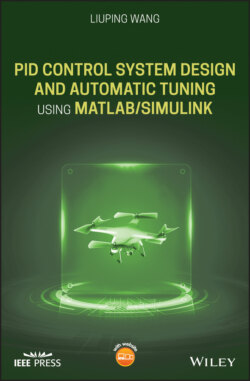Читать книгу PID Control System Design and Automatic Tuning using MATLAB/Simulink - Liuping Wang - Страница 40
Example 1.8
ОглавлениеConsider the same third order system with time delay used in Example 1.7. Find the PI and PID controller parameters using Padula and Visioli tuning rules and simulate their closed-loop step response.
Solution. The parameters used in the tuning rules are , , and . To evaluate the PI controller performance, Table 1.4 is used to calculate the controller parameters. For , we have and . For , we have and .
With sampling interval (s), the closed-loop step responses are compared in Figure 1.19, where the IP controller structure is used to reduce overshoot to the step reference signal. It is clearly seen that the closed-loop system with is stable; however, with it is not.
Now, we evaluate the closed-loop performance for a PID controller with filter, where the filter time constant is chosen to be . Based on Table 1.5, the PID controller parameters are calculated as for , , , , and for , , , .
Figure 1.19 Comparison of closed-loop responses using Padula and Visioli PI controller (Example 1.8). (a) Control signal. (b) Output. Key: line (1) tuning rule with ; line (2) tuning rule with .
Figure 1.20 Comparison of closed-loop responses using Padula and Visioli PID controller (Example 1.8). (a) Control signal. (b) Output. Key: line (1) tuning rule with ; line (2) tuning rule with .
With the same sampling interval , and both proportional and derivative control on output only (IPD structure) where the derivative filter time constant is selected as , the closed-loop responses are simulated. Figure 1.20 compares the closed-loop responses. Both tuning rules lead to stable closed-loop control systems. It is seen that there are overshoots in both reference responses, which was caused by the quite large derivative gains.
